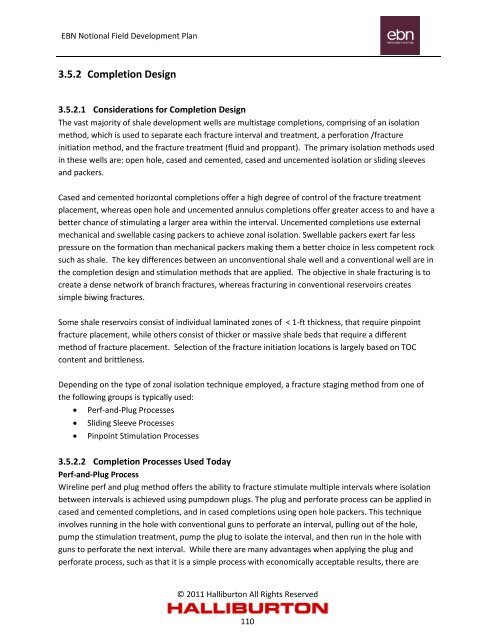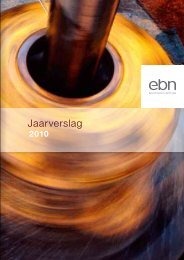Notional Field Development Final Report - EBN
Notional Field Development Final Report - EBN
Notional Field Development Final Report - EBN
You also want an ePaper? Increase the reach of your titles
YUMPU automatically turns print PDFs into web optimized ePapers that Google loves.
<strong>EBN</strong> <strong>Notional</strong> <strong>Field</strong> <strong>Development</strong> Plan<br />
3.5.2 Completion Design<br />
3.5.2.1 Considerations for Completion Design<br />
The vast majority of shale development wells are multistage completions, comprising of an isolation<br />
method, which is used to separate each fracture interval and treatment, a perforation /fracture<br />
initiation method, and the fracture treatment (fluid and proppant). The primary isolation methods used<br />
in these wells are: open hole, cased and cemented, cased and uncemented isolation or sliding sleeves<br />
and packers.<br />
Cased and cemented horizontal completions offer a high degree of control of the fracture treatment<br />
placement, whereas open hole and uncemented annulus completions offer greater access to and have a<br />
better chance of stimulating a larger area within the interval. Uncemented completions use external<br />
mechanical and swellable casing packers to achieve zonal isolation. Swellable packers exert far less<br />
pressure on the formation than mechanical packers making them a better choice in less competent rock<br />
such as shale. The key differences between an unconventional shale well and a conventional well are in<br />
the completion design and stimulation methods that are applied. The objective in shale fracturing is to<br />
create a dense network of branch fractures, whereas fracturing in conventional reservoirs creates<br />
simple biwing fractures.<br />
Some shale reservoirs consist of individual laminated zones of < 1-ft thickness, that require pinpoint<br />
fracture placement, while others consist of thicker or massive shale beds that require a different<br />
method of fracture placement. Selection of the fracture initiation locations is largely based on TOC<br />
content and brittleness.<br />
Depending on the type of zonal isolation technique employed, a fracture staging method from one of<br />
the following groups is typically used:<br />
• Perf-and-Plug Processes<br />
• Sliding Sleeve Processes<br />
• Pinpoint Stimulation Processes<br />
3.5.2.2 Completion Processes Used Today<br />
Perf-and-Plug Process<br />
Wireline perf and plug method offers the ability to fracture stimulate multiple intervals where isolation<br />
between intervals is achieved using pumpdown plugs. The plug and perforate process can be applied in<br />
cased and cemented completions, and in cased completions using open hole packers. This technique<br />
involves running in the hole with conventional guns to perforate an interval, pulling out of the hole,<br />
pump the stimulation treatment, pump the plug to isolate the interval, and then run in the hole with<br />
guns to perforate the next interval. While there are many advantages when applying the plug and<br />
perforate process, such as that it is a simple process with economically acceptable results, there are<br />
© 2011 Halliburton All Rights Reserved<br />
110







